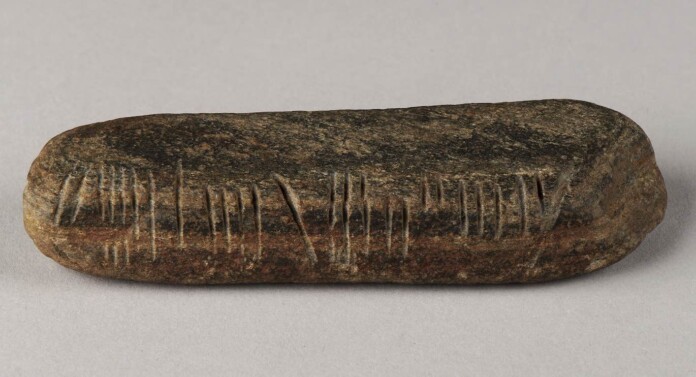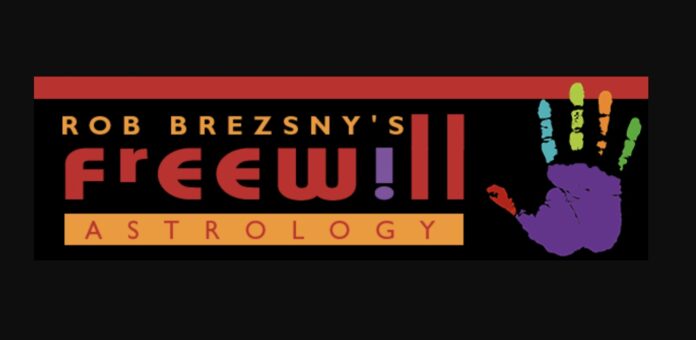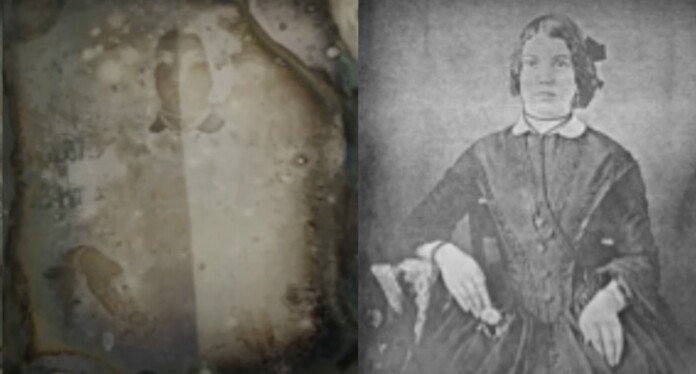565 years ago today, Jodhpur, the “Sun City,” the “Blue City,” was founded amid the stark lands of the Thar Desert in Rajasthan, India. In 1459, Rao Jodha Rathore succeeded in conquering the surrounding territory from the Delhi Sultanate and thus founded a kingdom that came to be known as Marwar. Located on the strategic road linking Delhi to Gujarat, it was able to profit from a flourishing trade in opium, copper, silk, sandalwood, dates, and other tradeable goods. READ more about the city… (1459)
Dogs Placed in Elementary Schools Making a Big Difference in Academics and Mental Health for Michigan Students

To help reduce anxiety—and open the way for learning—several elementary schools in Michigan have enrolled service dogs as full-time happiness ambassadors—and it is paw-sitively working.
Students are “already seeing a big difference in their academics,” according to a news report from WXMI-TV 17.
Priority Health, a Michigan health insurance provider, launched Priority Pups in September when goldendoodles were placed in two of the state’s school districts, “with more to come”.
“I love you, Meeka,” said Shelby, a student at North Godwin Elementary School who was snuggled up with the pup, which serves in a different classroom every day.
Research shows the presence of a trained dog lowers children’s stress, fosters a positive attitude toward learning, and smooths interactions between classmates.
A 2023 report from Mental Health America found that many youth in Michigan with clinical depression did not receive any mental health treatment.
Shelby’s mom, Laurie Uhl, described the difference Meeka is making in her daughter’s life.
“Shelby was diagnosed with a genetic disorder called Fragile X Syndrome, along with autism and ADHD. Here at school, she really struggles with a range of emotions.
“She gets angry and will cry or scream uncontrollably.”
But since Meeka the goldendoodle arrived at school, there is a guaranteed way to bring calm to the situation.

“I’ve seen Shelby having a meltdown and when Meeka is brought into the room, I can see a breath of fresh air wash over her and she finds comfort.”
It’s not only the stressed-out students that benefit from sitting with the pup during the day.
Research shows that literacy scores went up for children after they read to dogs.
“My math was super hard,” one fifth-grader told WXMI-TV. “But then Meeka came in and when I take a break with her for a few minutes. Then math became really easy.”
The program was made possible by Canines for Change, founded in 2005 by Dr. Nikki Brown, a school psychologist for the Lansing School District in Michigan.

Dr. Brown began taking her Corgi to school, to work with special education students, and noticed a drastic improvement in their skills and behavior with the addition of a dog.
RANDOM PUPPY LOVE: After Losing My Dog, Neighbors on Nextdoor Loaned Me Their Own Pups to Grieve
So she teamed up with another trainer to be able to offer service dogs for children with special needs.
Three years ago, Canines for Change was approached by their local Grand Ledge School District to place a Facility Dog in each of their nine school buildings. When Priority Health heard about it, they began funding their own program for schools, Priority Pups.
WATCH their heartwarming video below…
AND, watch the school featured in WXMI-TV 17…
SHARE THE PAWESOME IDEA With Your Own Local Schools on Social Media…
Teacher Finds ‘Amazing’ Stone Carved With Ancient Celtic Script While Digging in His Garden
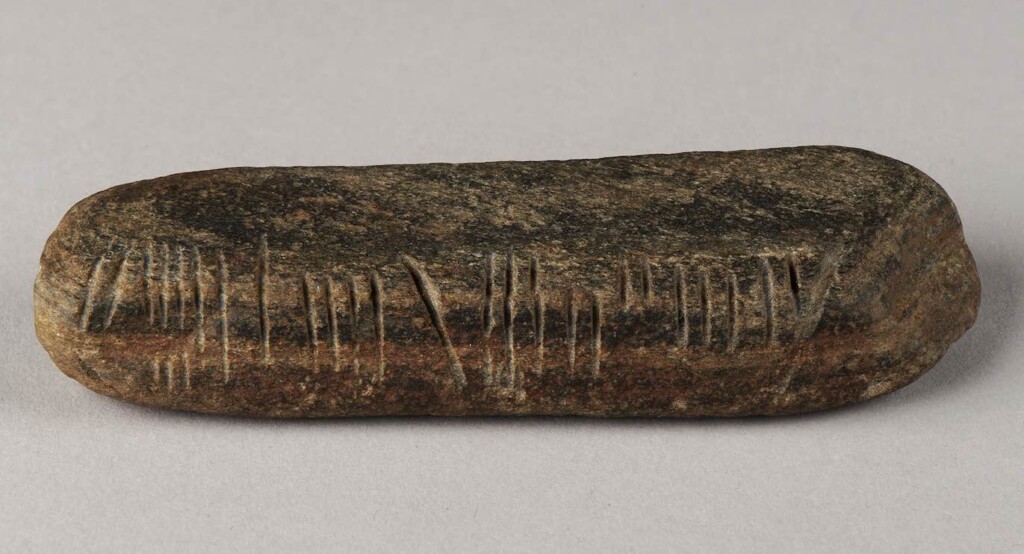
A teacher was left stunned after digging up a stone carved with an ancient Celtic script dating back to the 4th Century while weeding in his garden.
Now, the 4-inch stone (11cm) has gone on display at a museum while experts continue to figure out the full meaning of the mysterious relic.
During the lockdowns of May 2020, many of us found ourselves digging in gardens like Graham Senior. The 55-year-old was clearing out his overgrown flowerbed in Coventry, England when he made the incredible discovery .
It has since emerged the sandstone rock bears an early form of Ogham script from Ireland, dating back around 1,600 years.
The rectangular block features a series of lines inscribed on three sides in a script primarily used in early medieval Ireland.
Scottish historian Professor Katherine Forsyth, from the University of Glasgow, has partially translated the words to reveal a name, “Mael Dumcail”—and the geography teacher who found it believes it was the name of a lover.
“My house sits about 100 yards away from a Roman fort called Lunt which is a visitor attraction and sits downstream of the River Sowe.
“We think a Roman soldier must have been walking away from there when he dropped it.
“It was possibly a keepsake from a sweetheart who he had been left behind in Ireland—but its still obviously quite a mystery.
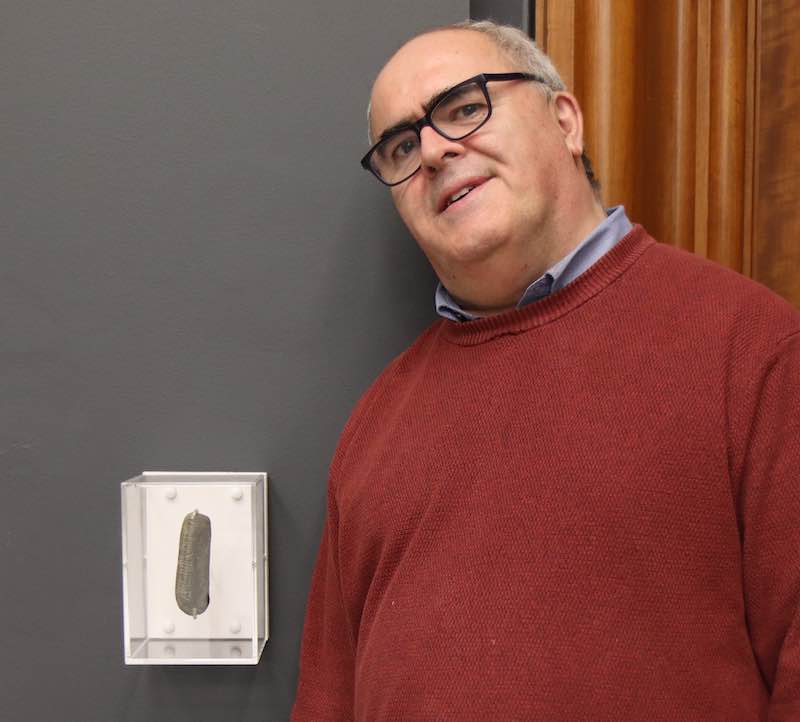
“It’s a very tactile thing. When you have it in your hand, it just feels right, as if it was meant to be held.
LOOK: Boy Finds Rare Gold Roman Bracelet in a Field Where it Was Lying for 2,000 Years
When the married father-of-two found it in the dirt, he immediately became curious.
“I just saw this thing sticking out of the flowerbed after digging about four or five inches down and thought, ‘that’s not normal’.
“I could tell they were not scratchings from an animal or anything like that and decided to investigate a little further.
“My wife has a friend who is an archeologist and we told her about it, expecting her to not be very impressed.
“But she began getting very excited about it and before we knew it, we were in touch with the local finds officer and various museums from up and down the country.
“I never knew it at the time but it turned out to be quite a remarkable thing to find while weeding out the flowerbed.”
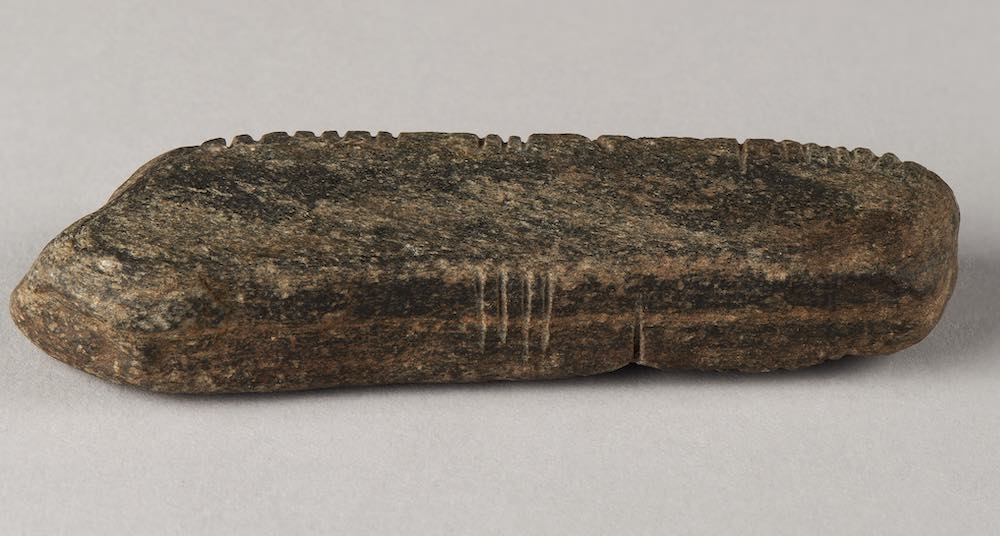
“The Herbert Art Gallery and Museum now has it, but they have done me a nice 3D replica so I do have a nice memento from it.”
Teresa Gilmore, finds liaison officer for Staffordshire and West Midlands, told the BBC it was an “amazing” find.
“Most Ogham inscriptions you generally find in the more Celtic areas—Scotland, Ireland and down in Cornwall—you don’t generally get them down in the Midlands.”
Although no one is yet 100 percent certain of what it actually is, Ms. Gilmore said another theory was that it could have been used by Irish tradesmen to make contact with each other, or linked to people coming over from Ireland to early medieval monasteries in the area.
AMAZING FIND: Amateur Fossil Hunter Calls Her Shot, Finding a Giant Mammoth Tooth After Declaring She Would on Her Birthday
Ali Wells, a curator at the museum where it is displayed in Coventry, said, “It is really quite incredible. The language originates from Ireland, so to have found it here has been an exciting mystery.”
SHOW GARDENERS What To Look For, By Sharing on Social Media…
Cancer Vaccine Triggers Fierce Immune Response to Fight Malignant Brain Tumors in Human Patients

In a first-ever human clinical trial, an mRNA cancer vaccine developed at the University of Florida successfully reprogrammed patients’ immune systems to fiercely attack glioblastoma, the most aggressive and lethal brain tumor.
The results in four adult patients mirrored those in 10 pet dog patients suffering from brain tumors whose owners approved of their participation.
The discovery represents a potential new way to recruit the immune system to fight treatment-resistant cancers using an iteration of mRNA technology and lipid nanoparticles, similar to COVID-19 vaccines, but with two key differences: use of a patient’s own tumor cells to create a personalized vaccine, and a newly engineered complex delivery mechanism within the vaccine.
“Instead of us injecting single particles, we’re injecting clusters of particles that are wrapping around each other like onions,” said senior author Elias Sayour, M.D., Ph.D., a UF Health pediatric oncologist who pioneered the new vaccine, which like other immunotherapies attempts to “educate” the immune system that a tumor is foreign.
“These clusters alert the immune system in a much more profound way than single particles would.”
Among the most impressive findings was how quickly the new method spurred a vigorous immune-system response to reject the tumor, said Sayour, principal investigator at the University’s RNA Engineering Laboratory and McKnight Brain Institute investigator who led the multi-institution research team.
“In less than 48 hours, we could see these tumors shifting from what we refer to as ‘cold’—very few immune cells, very silenced immune response—to ‘hot,’ very active immune response,” he said.
MORE BREAKTHROUGHS: Using the Body’s ‘Invisible Scalpel’ to Remove Brain Cancer With Immunotherapy at Salk Institute
“That was very surprising given how quick this happened, and what that told us is we were able to activate the early part of the immune system very rapidly against these cancers, and that’s critical to unlock the later effects of the immune response,” he explained in a video (below).
Glioblastoma is among the most devastating diagnoses, with median survival around 15 months. Current standard of care involves surgery, radiation and some combination of chemotherapy.
The new report, published May 1 in the journal Cell, is the culmination of seven years of promising studies, starting in preclinical mouse models.
In the cohort of four patients, genetic material called RNA was extracted from each patient’s own surgically removed tumor, and then messenger RNA (mRNA)—the blueprint of what is inside every cell, including tumor cells—was amplified and wrapped in the newly designed high-tech packaging of biocompatible lipid nanoparticles, to make tumor cells “look” like a dangerous virus when reinjected into the bloodstream to prompt an immune-system response.
TAKE NOTE: Vitamin D Improves Immunity to Cancer And Reduces Tumor Growth in Mice, Study Finds
The vaccine was personalized to each patient with a goal of getting the most out of their unique immune system.
“The demonstration that making an mRNA cancer vaccine in this fashion generates similar and strong responses across mice, pet dogs, and human patients is a really important finding, because oftentimes we don’t know how well the preclinical studies in animals are going to translate into similar responses in patients,” said Duane Mitchell, M.D., Ph.D., director of the UF Clinical and Translational Science Institute and a co-author of the paper. “This is a novel and unique way of delivering the mRNA to generate these really significant and rapid immune responses that we’re seeing across animals and humans.”
While too early in the trial to assess the clinical effects of the vaccine, the patients either lived disease-free longer than expected or survived longer than expected. The 10 pet dogs lived a median of 4.5 months, compared with a median survival of 30-60 days typical for dogs with the condition.
AMAZING BRAIN CANCER WORK: CAR-T Cell Therapy Achieves Near-Complete Tumor Regression in Brain Cancer After 5 Days
The next step, with support from the Food and Drug Administration and the CureSearch for Children’s Cancer foundation, will be an expanded Phase I clinical trial to include up to 24 adult and pediatric patients to validate the findings. Once an optimal and safe dose is confirmed, an estimated 25 children would participate in Phase 2.
For the new clinical trial, Sayour’s lab will partner with the multi-institution Pediatric Neuro-Oncology Consortium, to send the immunotherapy treatment to children’s hospitals across the country. They will do this by receiving an individual patient’s tumor, manufacturing the personalized vaccine at UF and sending it back to the patient’s medical team, said Sayour, co-leader of the Immuno-Oncology and Microbiome research program at the UF Health Cancer Center.
“I am hopeful that this could be a new paradigm for how we treat patients, a new platform technology for how we can modulate the immune system,” said Sayour in a UF Health news report by Michelle Jaffee. “We showed in this paper that you actually can have synergy with other types of immunotherapies, so maybe now we can have a combination approach to unlock those immunotherapies.”
SHARE THE GOOD NEWS With Cancer Patients Across Social Media…
Your Weekly Horoscope – ‘Free Will Astrology’ From Rob Brezsny
Our partner Rob Brezsny, who has a new book out, Astrology Is Real: Revelations from My Life as an Oracle, provides his weekly wisdom to enlighten our thinking and motivate our mood. Rob’s Free Will Astrology, is a syndicated weekly column appearing in over a hundred publications. He is also the author of Pronoia Is the Antidote for Paranoia: How All of Creation Is Conspiring To Shower You with Blessings. (A free preview of the book is available here.)
Here is your weekly horoscope…
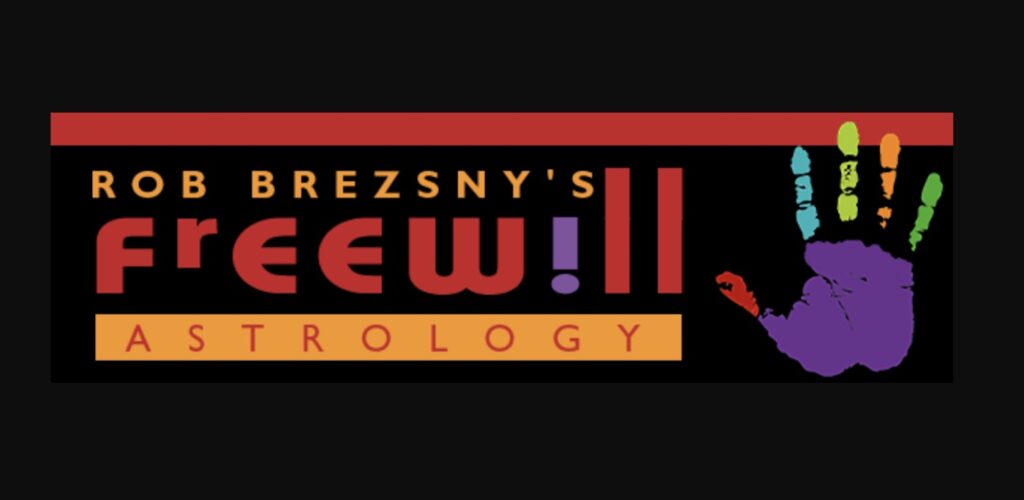
FREE WILL ASTROLOGY – Week of May 11, 2024
Copyright by Rob Brezsny, FreeWillAstrology.com

TAURUS (April 20-May 20):
Keizoku wa chikara nari is a Japanese proverb that means “To continue is power.” I propose you make that your motto for the next four weeks. Everything you need to happen and all the resources you need to attract will come your way as long as your overarching intention is perseverance. This is always a key principle for you Tauruses, but especially now. If you can keep going, if you can overcome your urges to quit your devotions, you will gain a permanent invigoration of your willpower.

GEMINI (May 21-June 20):
Do you believe there are divine beings, animal spirits, and departed ancestors who are willing and able to help us? If not, you may want to skip this horoscope. I won’t be upset if you feel that way. But if you do harbor such views, as I do, I’m pleased to tell you that they will be extra available for you in the coming weeks. Remember one of the key rules about their behavior: They love to be asked for assistance; they adore it when you express your desires for them to bring you specific blessings and insights. Reach out, Gemini! Call on them.

CANCER (June 21-July 22):
I’m taking a gamble here as I advise you to experiment with the counsel of visionary poet and painter William Blake (1757–1825). It’s a gamble because I’m asking you to exert a measure of caution as you explore his daring, unruly advice. Be simultaneously prudent and ebullient, Cancerian. Be discerning and wild. Be watchful and experimental. Here are Blake’s directions: 1. The road to excess leads to the palace of wisdom, for we never know what is enough until we know what is more than enough. 2. If the fool would persist in his folly, he would become wise. 3. The pride of the peacock is the glory of God. The lust of the goat is the bounty of God. 4. No bird soars too high if it soars with its own wings. 5. Exuberance is Beauty.

LEO (July 23-Aug. 22):
Cosmic energies are staging a big party in your astrological House of Ambition. It’s a great time to expand and intensify your concepts of what you want to accomplish with your one wild and precious life. You will attract unexpected help as you shed your inhibitions about asking for what you really want. Life will benevolently conspire on your behalf as you dare to get bolder in defining your highest goals. Be audacious, Leo! Be brazen and brave and brilliant! I predict you will be gifted with lucid intuitions about how best to channel your drive for success. You will get feelers from influential people who can help you in your quest for victory. (PS: The phrase “your one wild and precious life” comes from poet Mary Oliver.)

VIRGO (Aug. 23-Sept. 22):
Is it possible to be too smart for your own good? Maybe, although that won’t be a problem for you anytime soon. However, you may temporarily be too smart for some people who are fixated on conventional and simplistic solutions. You could be too super-brilliant for those who wallow in fear or regard cynicism as a sign of intelligence. But I will not advise you to dumb yourself down, dear Virgo. Instead, I will suggest you be crafty and circumspect. Act agreeable and humble, even as you plot behind the scenes to turn everything upside-down and inside-out—by which I mean, make it work with more grace and benefit for everyone concerned.

LIBRA (Sept. 23-Oct. 22):
In my fairy tale about your life in the coming weeks and months, you will transform from a crafty sleuth to an eager explorer. You will finish your wrestling matches with tricky angels and wander off to consort with big thinkers and deep feelers. You will finish your yeoman attempts to keep everyone happy in the human zoo and instead indulge your sacred longings for liberation and experimentation. In this fairy tale of your life, Libra, I will play the role of your secret benefactor. I will unleash a steady stream of prayers to bless you with blithe zeal as you relish every heart-opening, brain-cleansing moment of your new chapter.

SCORPIO (Oct. 23-Nov. 21):
In the coming months, I will encourage you to keep deepening and refining the art of intimacy. I will rejoice as you learn more and more about how to feel close to people you care for and how to creatively deal with challenges you encounter in your quest to become closer. Dear Scorpio, I will also cheer you on whenever you dream up innovations to propitiate togetherness. Bonus blessings! If you do all I’m describing, your identity will come into brighter focus. You will know who you are with greater accuracy. Get ready! The coming weeks will offer you novel opportunities to make progress on the themes I’ve mentioned.

SAGITTARIUS (Nov. 22-Dec. 21):
You could offer a workshop on the perks of wobbliness. Your anxious ruminations and worried fantasies are so colorful that I almost hesitate to tell you to stop. I’m wondering if this is one of those rare phases when you could take advantage of your so-called negative feelings. Is it possible that lurking just below the uneasiness are sensational revelations about a path to liberation? I’m guessing there are. To pluck these revelations, you must get to the core of the uneasiness.

CAPRICORN (Dec. 22-Jan. 19):
During the last 11 months, life has offered you unprecedented opportunities to deepen and ripen your emotional intelligence. You have been vividly invited to grow your wisdom about how to manage and understand your feelings. I trust you have been capitalizing on these glorious teachings. I hope you have honed your skills at tapping into the power and insights provided by your heart and gut. There’s still more time to work on this project, Capricorn. In the coming weeks, seek out breakthroughs that will climax this phase of your destiny.

AQUARIUS (Jan. 20-Feb. 18):
Naturalist and author Henry David Thoreau declared, “We need the tonic of wildness.” Amen! In my view, you Aquarians especially need this sweet, rugged healing power in the coming weeks. Borrowing more words from Thoreau, I urge you to exult in all that is mysterious, unsurveyed, and unfathomable. Like Thoreau, I hope you will deepen your connection with the natural world because it “it is cheerfully, musically earnest.” Share in his belief that “we must go out and re-ally ourselves to Nature every day. We must take root, send out some little fiber.”

PISCES (Feb. 19-March 20):
I have four questions and homework assignments for you, Pisces. 1. Is there a person in your inner circle who is close to ripening a latent talent that would ultimately benefit you? I suspect there is. What can you do to assist them? 2. Is there a pending gift or legacy that you have not yet claimed or activated? I think so. What would be a good first step to get it fully into your life? 3. What half-dormant potency could you call on and use if you were more confident about your ability to wield it? I believe you now have the wherewithal to summon the confidence you need. 4. What wasteful habit could you replace with a positive new habit?

ARIES (March 21-April 19):
When my friend Jessalyn first visited Disneyland as a child, she was smitten by its glimmering, unblemished mystery. “It was far more real than real,” she said. “A dream come true.” But after a few hours, her infatuation unraveled. She began to see past the luster. Waiting in long lines to go on the rides exhausted her. The mechanical elephant was broken… The days ahead may have resemblances to Jessalyn’s awakening for you. This slow-motion jolt might vex you initially, although I believe it’s a healthy sign. It will lead to a cleansed perspective that’s free of illusion and teeming with clarity.
WANT MORE? Listen to Rob’s EXPANDED AUDIO HOROSCOPES, 4-5 minute meditations on the current state of your destiny — or subscribe to his unique daily text message service at: RealAstrology.com
(Zodiac images by Numerologysign.com, CC license)
SHARE The Wisdom With Friends Who Are Stars in Your Life on Social Media…
“We need the tonic of wildness.” – Henry David Thoreau
Quote of the Day: “We need the tonic of wildness.” – Henry David Thoreau
Photo by: Johannes Plenio
With a new inspirational quote every day, atop the perfect photo—collected and archived on our Quotes page—why not bookmark GNN.org for a daily uplift?

Good News in History, May 11
120 years ago today, Salvador Dali was born. Known for his striking and bizarre images, he is one of, if not the most famous surrealist painter in history. Inspired by the Renaissance masters, Dali nevertheless gravitated to the surrealist movements in the early 20th century. He would live in France for the duration of the Spanish Civil War, before moving to America and achieving commercial success. SEE a Couple of His Most Famous Works… (1904)
The ‘World’s Largest’ Vacuum to Suck Up Carbon Emissions Begins Operating in Iceland

A pair of climate-solution firms have just turned on the largest CO2 vacuum in the world, capable of sucking thousands of tons of carbon out of the atmosphere.
In 2021, GNN reported on the operation of the Orca facility in Iceland, run by the firm CarbFix in partnership with the Swiss company Climeworks. The company said it can pull 4,000 tons of CO2 out of the atmosphere every year, the equivalent of taking 870 cars off the road.
Now though, they’ve outdone Orca’s output 10 times with the Mammoth plant in Hellisheiði Iceland.
Sucking 36,000 tons of carbon out of the air every year with Climeworks’ modular, stackable intake fans, CarbFix’s unique technology deposits the carbon deep underground where it will mineralize and not emerge for hundreds of millions, perhaps billions of years.
The whole thing will be powered by geothermal energy, making it carbon-negative.
Mammoth and Orca are projects known as Direct Air Capture (DAC), which many criticize as being unproven or too expensive.
But scientists have begun predicting that carbon will have to be removed from the atmosphere to prevent the worst effects associated with a 2°C increase in average global temperatures, in addition to simply scaling back how much carbon is emitted.
MORE FROM ICELAND: Iceland To Hang Up Her Harpoons For Good, Issuing No More Whaling Permits
Several other large operations are in the process of being planned or built, including a massive one in Wyoming that aims to capture 5,000,000 tons annually.
Climeworks didn’t give an exact price of the carbon credit, but said it would be closer to $1,000 than $100, the number that many feel needs to be reached for DAC plants to run sustainably.
ALSO CHECK OUT: U.S. to Plug More than 10,000 Abandoned Carbon-Emitting Oil and Gas Wells in 24 States
In September 2022, just months after Orca first came online, Climeworks announced plans to scale up in the United States.
The company outlined its intent to engage in several large-scale DAC projects over the next few years, with the potential to create thousands of direct U.S. jobs in the process.
SHARE This Seriously Impressive Climate Solution With Your Friends…
Texas Food Bank Builds Housing for the People Who Need Their Food–Right Next Door

A food bank in a fast-growing Texas community is building affordable housing next to its bank, to ensure people who have to juggle food and rent are able to, with minimal effort.
The 51-unit apartment complex hasn’t gone up yet, but planning has begun for facilities that would temporarily house people struggling to afford the cost of living while undertaking job training or studies.
30 minutes outside San Antonio lies one of the fastest-growing towns in the US: New Braunfels.
Here, homelessness is growing due to an exploding population. The New Braunfels branch of the San Antonio food bank wondered if they could do more than just cover the cost of food.
“What we know about a food insecure household is that rent eats first in every household budget,” says Eric Cooper, president and CEO of the San Antonio Food Bank.
“If we can provide food, that in some ways allows a family to cost-shift their dollars to stay housed. For food banks across the country, hundreds of millions of dollars in the value of food is offsetting rent payments going to landlords.”
Cooper told Adele Peters of Fast Company that despite believing they could do more, the board of directors of the food bank was worried about ‘mission creep’—trying to do too much and ending up doing several things poorly.
MORE TEXAS NEWS: High-Speed Railway Progresses Towards a 200-mph Train Line From Dallas to Houston
But the opportunity was there to make the leap when a vacant lot next to their location had been sought after by local organizations working on homelessness. A foundation purchased the land, but they needed someone to take on the building.
After long deliberations, the board came to the conclusion that their purpose was to help their neighbors, whether that be with food or housing.
ANOTHER INNOVATIVE SOCIAL ENTERPRISE: They’ve Collected 20 Million Pounds of Food From People Who are Moving—And Delivered it to Food Banks
Partnering with Open Studio Architecture, the food bank is planning a 51-unit complex that will be rented to families with children for a period of 24-36 months that may have either one or two earners who are currently undergoing training or education for a job that pays enough to support the family outright.
Cooper believes it’s the first affordable housing complex ever built by a food bank.
SHARE This Food Bank’s Great Idea With Your Friends…
Photographer Creates Stunning Artwork by Taking Close-up Images of Eyes–Each One Is Unique

Andriana Green captures the unique patterns and colors of the human iris
before transforming the results into beautiful works of art.
Stunning macro images show the ‘windows of the soul’ looking like other-worldly planets, as a yin and yang and also connected as wheels on a bike.
The colorful new photography trend has increasingly seen couples and families getting their pupils snapped up close for a unique keepsake.
Green says everyone’s eye is different, reflecting our personality, emotions, and identity.
Her photos show the complex and intricate textures hidden within the human iris which gives our eyes a unique character.
“I used to think people had just green, brown, or blue eyes,” said Andriana, who lives with husband Cameron and their three-year-old daughter Nicole. “But with these pictures you can really see all the different lines and areas of the eye, everyone really is unique,” she said, comparing them to snowflakes or fingerprints.
“I find them truly beautiful and fascinating. They look like something from outer space, almost like planets by themselves.

“I’m originally from Bulgaria and found out about the trend a few months ago when we went back to visit some family. There was a big international business fair taking place in the city, so we went along to see what was happening and that’s when I saw it.”
PHOTOGRAPHY IDEAS: Say Cheese… for a Thousand Years: Camera Set up to Capture a Millennium-long Exposure of Tucson
“It is becoming more in demand here too so I thought I’d give it a go and it is proving popular with people wanting a different family portrait,” she adds.
“I mostly concentrate on family and children’s photography but in a matter of weeks, this seems to be quite sought after.”
In order to take the close-up pictures, Green says it’s necessary to shine a continuous light into the eyes, meaning her subjects will be required to sit completely still for a few minutes.
For this reason, she says this type of photography might not be suitable for younger children or anyone who suffers from light sensitivity.
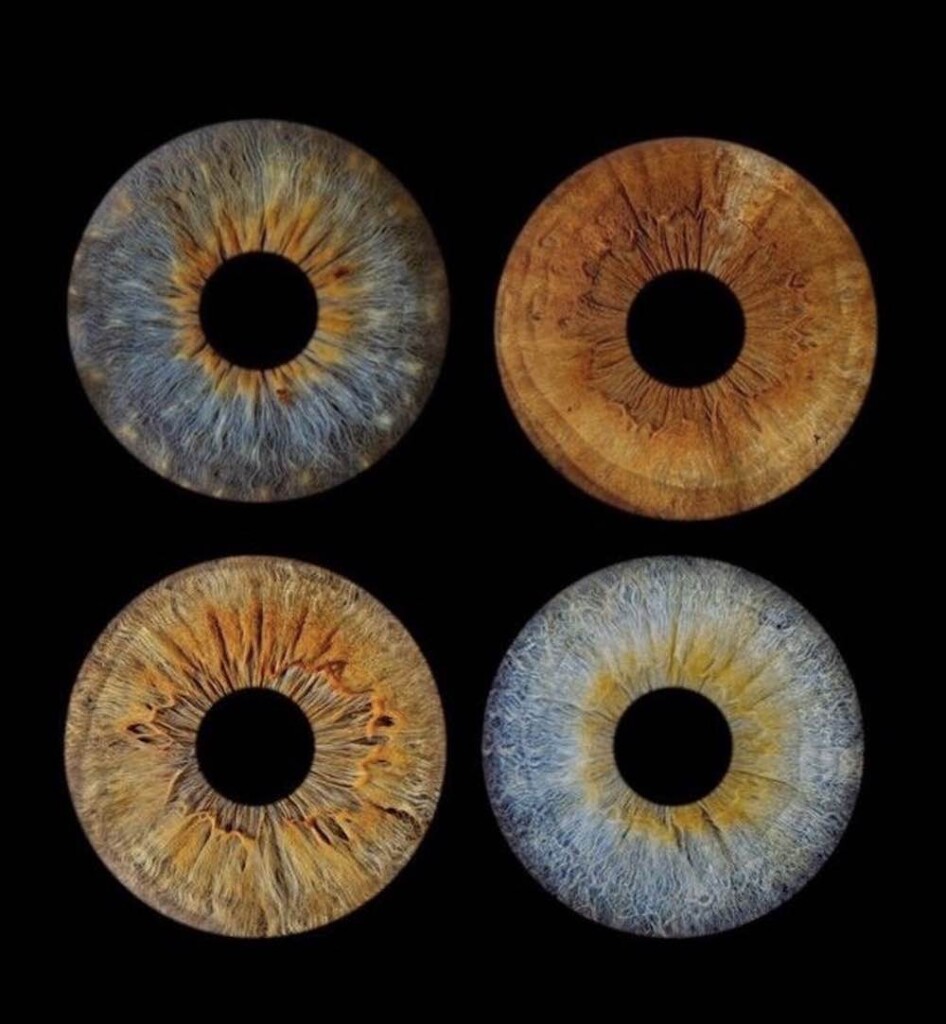
MORE STORIES LIKE THIS: See What Magic Happens When a Photographer Adds Himself to Famous Album Covers – LOOK
“The process of taking the pictures only takes about half an hour but the editing takes three to four hours, so that is the time-consuming part,” said Green, who runs Moonlight Photography.
“The finished pictures make a really unique piece of art to hang on the walk and a great talking point.”
SHARE These Stunning, Alternative Portraits With Your Friends…
NOAA Predicts Potential Aurora as Far South as Alabama After Severe Solar Storm Witnessed

Having spotted peculiar activity on the Sun, a federal agency has issued an advisory that the Aurora Borealis may be seen as may south as Alabama or Northern California.
The Space Weather Prediction Center (SWPC)—a division of the National Weather Service—is monitoring the Sun following a series of solar flares and coronal mass ejections (CMEs) that began on May 8th.
These powerful ejections of plasma and radiation have the ability to disrupt telecommunications, navigation, and the electrical grid, and the SWPC detected a cluster of sunspots that produced five solar flares in succession.
“SWPC has notified the operators of these systems so they can take protective action. Geomagnetic storms can also trigger spectacular displays of aurora on Earth,” the SWPC said in a statement. “A severe geomagnetic storm includes the potential for aurora to be seen as far south as Alabama and Northern California.”
The center describes the severity of the CMEs as “very rare,” and warns they could arrive late on May 10th, or on May 11th.
MORE ABOUT AURORAS: Photographer Captures Jaw-Dropping Mysterious Spiral Over the Aurora with a Simple Explanation–(LOOK)
Much of the northern half of the country may be able to see an aurora either tonight or tomorrow morning.
The reason it’s called the Aurora Borealis is because it occurs in the Boreal zones. Highly excited plasma and radiation coming off the Sun is redirected by Earth’s magnetic field to the magnetic poles, creating an aurora in the Arctic and Antarctic, but depending on the quantity of radiation and plasma present, it can spill southwards.
SHARE This Amazing Opportunity To See The Northern Lights…
“Joy is prayer; joy is strength: joy is love.” – Mother Teresa
Quote of the Day: “Joy is prayer; joy is strength: joy is love.” – Mother Teresa
Photo by: Austin Schmid
With a new inspirational quote every day, atop the perfect photo—collected and archived on our Quotes page—why not bookmark GNN.org for a daily uplift?

Good News in History, May 10
200 years ago today, the National Gallery opened its doors to the public in Trafalgar Square, Westminster. It houses a collection of over 2,300 paintings dating from the mid-13th century to 1900. Unlike comparable museums in continental Europe, the National Gallery was not formed by nationalizing an existing royal or princely art collection. It came into being when the British government bought 38 paintings from the heirs of London businessman John Julius Angerstein in 1824. SEE some of the masterpieces…
Telecom Boxes Becoming EV Charging Stations Across Britain–60,000 Curbside Cabinets Could Be Adapted

British telecom giant BT Group is now converting curbside cable boxes into charging stations for electric cars, helping Great Britain accelerate its transition to a net zero emissions economy.
Many of BT’s existing curbside cabinets are becoming obsolete due to people moving to wireless telephone and cable provision, but the same lines that provide electricity to the boxes should be able to fully charge an electric vehicle in about 6 to 8 hours.
These street cabinets are known in the industry as DSLAM boxes, which stands for digital subscriber line access multiplier. 7.4 kilowatt-hours are delivered to them for the furnishing of various telecom services, which means no additional power lines need to be laid for a charging station, and no digging up of the existing cabinet infrastructure needs be done.
The first such conversion has already been done in a place called East Lothian, Scotland.
BT Group is envisioning a payment application over the phone, or via contactless payment hardware, but hasn’t released any pricing details.
With over 60,000 such DSLAM boxes across the UK, BT Group say they envision the conversion as an excellent opportunity to “repurpose existing street furniture.”
There are currently about 54,000 charging stations in the UK, but drivers’ number one reason for selecting an internal combustion engine vehicle is the anxiety that a charging station won’t be available along their route, if driving an EV.
DID YOU KNOW? There’s Now a Fast Charging EV Station for Every 5 Gas Stations in California
To alleviate this real concern, the government hopes to encourage or finance the construction of 300,000 charging stations, and BT is planning to retrofit as many as 600 DSLAM cabinets by the end of the year.
WATCH the excellent video about the project from Reuters, below…
SHARE THE ELECTRIC IDEA With EV Enthusiasts on Social Media…
World’s Largest Wildlife Crossing is Going Up So Animals Can Walk Safely Over 8 Lanes of L.A. Traffic

Construction of the “largest wildlife crossing in the world” passed a significant milestone in April placing the first girders over an 8-lane freeway near Los Angeles to preserve the local mountain lion population.
After years of tireless work, erecting the first horizontal section of the 210-foot-long crossing was an historic moment for the National Wildlife Federation, the Caltrans highway department, and many private and public partners.
“We all cheered when the crane lowered the first concrete beam across the freeway, as we truly saw the bridge starting to take shape,” said an excited Beth Pratt, the California Executive Director of National Wildlife Federation.
“This structure is a testament to us all wanting a future for wildlife and mountain lions in the Santa Monica Mountains.”
Moving forward, up to 82 additional concrete girders will be placed, with each beam weighing between 126 and 140 tons. As these critical horizontal supports are placed, the structure will ultimately reconnect two long fractured global biodiversity hotspots in the Southern California region—providing safe passage for not only the cougars, but bobcats, deer, lizards, and coyotes, as they move between the Santa Monica Mountains and the Simi Hills of the Santa Susana mountain range.
The bridge will not only keep animals safe, it will reduce human-wildlife traffic accidents—as every year in the U.S. more than a million wildlife-vehicle collisions result in 200 deaths and 26,000 injuries to drivers and passengers.

Named the Wallis Annenberg Wildlife Crossing, project leaders began eight years ago raising the funds needed for the $92 million bridge.
They received donations from more than 3,000 private, philanthropic, and corporate institutions around the world. Then, in 2021, Wallis Annenberg and her foundation donated a $25 million challenge grant.
For drivers on the 101 Freeway in Agoura Hills, the construction is interrupting traffic from 11:00 PM to 4:00 AM on one side of the highway each week (Northbound or Southbound). The FAQs can be found here.
CBS news estimates about 1,500 of these wildlife passages have been built both over and under major highways and rural roads across America.
Watch CBS’s recent feature that highlights crossings over America’s longest highway, US 90, which runs across the northern states, and how a new US grant program is paving the way for more crossings…
DRIVE THIS GOOD NEWS to Animal Lovers and LA Drivers on Social Media…
Lost Faces Found: New Tech Reveals Hidden Images in Earliest Photographs
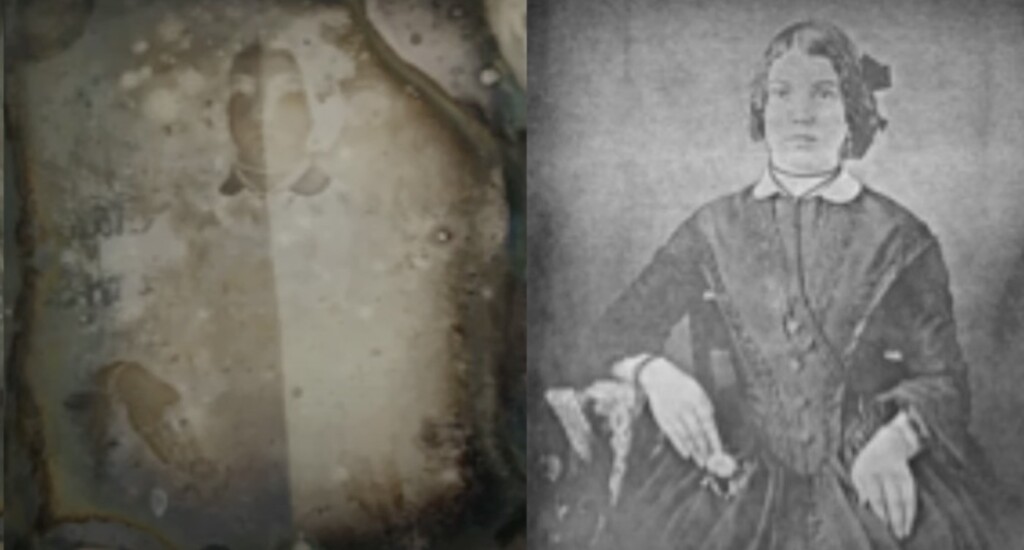
A team of Canadian and US researchers are using X-rays to revive the images that were captured in the 19th century on the earliest form of photography—Daguerreotypes.
Their breakthrough demonstrations have taken artifacts tarnished beyond all recognition and turned out stunningly clear images of the individuals whose portraits were captured all those years ago.
Tson-Kong Sham, the lead scientist on the project from Western University of Canada, patterned with the National Gallery to acquire Daguerrotypes that were completely tarnished for research that would involve using a synchrotron X-ray device to draw out certain elements present on the Daguerrotypes.
Daguerreotypes are one-of-a-kind, positive images made on thin sheets of silver-plated copper exposed to iodine, making the plate photosensitive upon the formation of silver iodide, Sham and his colleagues write in their paper, published in the Journal of Cultural Heritage.
Later variations utilized alternative halogens, such as chlorine, bromine, or a combination, to increase the sensitivity of the surface to light. The photosensitive plate is mounted in the lightproof interior of a camera; then the lens cap is removed, exposing the plate to light which results in photolysis and eventually an image in silver halide particles. An application of mercury seals the image and is the most important step.
Introduced in 1839, this new method of image-making quickly captured public interest and was sought-after until the mid-1850s, when it was gradually replaced with paper photographs.
PEER INTO THE PAST: German Museums Work Year-Round to Find Rightful Heirs to Hundreds of Stolen Jewish Silver Pieces
In their study using a synchrotron X-ray emitter, the scientists could tune the energy delivered to a threshold known as the absorption edge. At this stage, the core electrons absorb the X-rays at abruptly higher levels, and the molecule emits the energy back as an X-ray characteristic of the element.
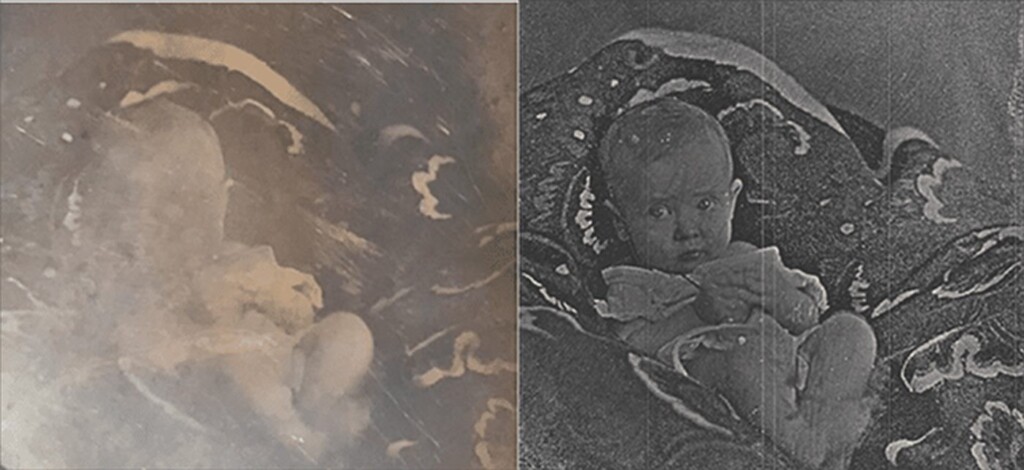
Targeting compounds like silver, mercury, or chloride, they can re-create, pixel by pixel, the image on a Daguerroptype that is completely tarnished.
The results can be seen in the photos they released of the Daguerrotypes they tested: and promise a whole new way of exploring the intimate details of our ancestors’ lives. Many museums hold collections of these images which have completely or partially degraded.
MORE STORIES LIKE THIS: Wasabi Can Be Used as Ecofriendly Preservation Tool for the Ancient Knowledge Contained on Papyrus
“Revealing images that seemed lost forever is what’s most exciting,” Sham told Science Alert. “We get a glimpse of people living in the 19th century that we wouldn’t have otherwise and learn about their history and culture.”
What’s more, this technique can also be used to get additional details out of all kinds of materials of scientific interest, such as fossils or artifacts of metal or wood, and Sham says it can be used really in “all walks of science.”
SHARE This Amazing View To View The Past With Your Friends…
Number of Fish on US Overfishing List Reaches All-Time Low–Led by Mackerel and Snapper
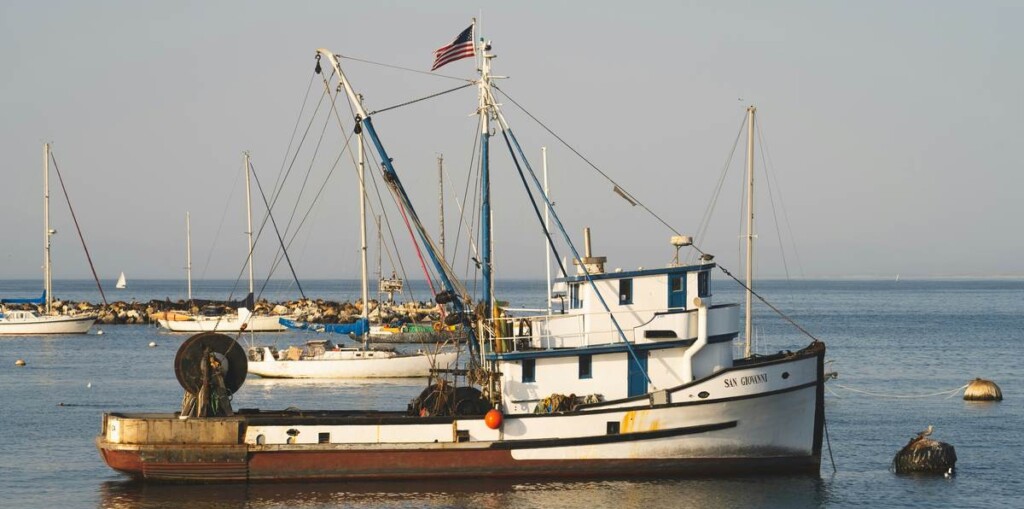
According to a recent federal report, the US seafood industry has never been more sustainable, with the fewest overharvested fish stocks ever recorded.
The report, ‘Status of the Stocks’ was published by the National Oceanic and Atmospheric Administration, and it also shows the strength of an industry that’s worth $8 billion a year.
94% of fish stocks in the US oceanic and gulf waters are not being overfished, according to the report, an all-time high after the number climbed slightly from last year.
The NOAA keeps a list of all the fisheries in the country that are subject to overfishing, and the agency said it has recently removed several species: a Gulf of Maine and Cape Hatteras stock of Atlantic mackerel and the Gulf of Mexico stock of cubera snapper.
2022 saw the removal of the Atlantic coast bluefish and a Washington Coast stock of coho salmon.
“By ending overfishing and rebuilding stocks, we are strengthening the value of U.S. fisheries to the economy, our communities, and marine ecosystems,” said Rick Spinrad, NOAA’s administrator.
FISHING AROUND THE WORLD: 4 Tuna Species Recovered After Decade of Fishing Quotas–With Albacore in Stores Being Truly Sustainable
GNN recently reported that after decades of overfishing in the northwest Atlantic Ocean, hake fisheries off the coast of Spain are as large as ever thanks to timely and targeted conservation measures.
Additionally, Maine’s Penobscot River recently saw record numbers of Atlantic salmon returning to spawn, but the real trendsetters that far north have been blueback river herring and alewives, which entered the Penobscot in numbers that more than double the previous record.
SHARE This Great News From Our Seas With Your Friends…
“Change your life today. Don’t gamble on the future, act now, without delay.” – Simone de Beauvoir
Quote of the Day: “Change your life today. Don’t gamble on the future, act now, without delay.” – Simone de Beauvoir
Photo by: Zdeněk Macháček
With a new inspirational quote every day, atop the perfect photo—collected and archived on our Quotes page—why not bookmark GNN.org for a daily uplift?

Good News in History, May 9
638 years ago today, the Treaty of Windsor, the world’s oldest international accord still in force, was signed between Great Britain and Portugal. It was signed and sealed by King Richard II of England and King John I of Portugal to cement commercial ties and mutual defense. Subjects of one king had the rights, under the treaty, to relocate to the kingdom of the other king without special procedure, and it also gave the right of both countries to trade on the terms enjoyed by the subjects of that country, rather than their monarchs. READ more… (1386)
Thousands Volunteer to Help Jane Austen Museum Solve Mystery of ‘Spidery’ Script in Brother’s Biography

An interesting event happened in the domain of classic English literature recently when a 78-page memoir of Jane Austen’s brother came into the hands of the Jane Austen House Museum, who were having difficulty reading the handwriting.
Comparing it to a citizen science project, the museum initially invited anyone interested in helping to email a request for a single page to transcribe, but despite being dead for over 200 years, the response from Austen fans was simply extraordinary, as the numbers who stepped up to help nearly broke the museum’s email server.
Sir Francis Austen had a long career in the Royal Navy, and a manuscript biography of his life and a book of watercolor paintings he made were both acquired at auction by the Jane Austen House Museum with financial backing from a national non-profit.
Along with pages written about his work in the Navy, with stations as far as Egypt, India, and China, it also contains content about home life including his childhood at Chawton, and settling in Southampton with his sisters.
“Jane Austen left so little facts on her life,” said head of collections, interpretation, and engagement at Jane Austen’s House, Sophie Reynolds.
“This is another piece of the puzzle that can go into the museum. Scholars will find it fascinating to pull things out. It’s about filling in some more of the details that sort of surrounded her. We can see the world a little bit as she would have done.”
The manuscript is written in the third person, and the last third was likely done with an arthritic hand, making the already extremely cultured penmanship “spidery” and even more difficult to understand.
Writing Pride and Prejudice, Sense and Sensibility, Mansfield Park, Emma, Northanger Abbey, and Persuasion all from a cottage in the Hampshire village of Chawton, Austen experienced only moderate success in her lifetime.
MORE EXCERPTS FROM HISTORY: 2,000-Year-old Scroll Burnt in Pompeii Decoded and Read for First Time by Three Genius Students
Since her books first appeared in Richard Bentley’s Standard Novels series in 1833, fifteen years after her death, they have rarely been out of print, a testament to which was the number of people who emailed the museum about helping with the transcribing.
“We have been completely overwhelmed by the incredible response we have had to our transcription project, receiving thousands of responses in just 24 hours,” the museum wrote. “As a result, we are no longer able to receive applications. Thank you for your interest and support.”
It will be fascinating to hear what’s uncovered in the coming months.
SHARE This Intriguing Story With Anyone You Know Who Loves Austen’s Books…






















